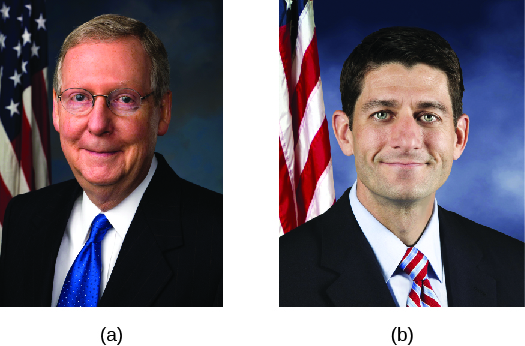| << Chapter < Page | Chapter >> Page > |
By the end of this section, you will be able to:
Not all the business of Congress involves bickering, political infighting, government shutdowns, and Machiavellian maneuvering. Congress does actually get work done. Traditionally, it does this work in a very methodical way. In this section, we will explore how Congress functions at the leadership and committee levels. We will learn how the party leadership controls their conferences and how the many committees within Congress create legislation that can then be moved forward or die on the floor.
The party leadership in Congress controls the actions of Congress. Leaders are elected by the two-party conferences in each chamber. In the House of Representatives, these are the House Democratic Conference and the House Republican Conference. These conferences meet regularly and separately not only to elect their leaders but also to discuss important issues and strategies for moving policy forward. Based on the number of members in each conference, one conference becomes the majority conference and the other becomes the minority conference. Independents like Senator Bernie Sanders will typically join one or the other major party conference, as a matter of practicality and often based on ideological affinity. Without the membership to elect their own leadership, independents would have a very difficult time getting things done in Congress unless they had a relationship with the leaders.
Despite the power of the conferences, however, the most important leadership position in the House is actually elected by the entire body of representatives. This position is called the Speaker of the House and is the only House officer mentioned in the Constitution. The Constitution does not require the Speaker to be a member of the House, although to date, all fifty-four Speakers have been. The Speaker is the presiding officer, the administrative head of the House, the partisan leader of the majority party in the House, and an elected representative of a single congressional district ( [link] ). As a testament to the importance of the Speaker, since 1947, the holder of this position has been second in line to succeed the president in an emergency, after the vice president.

The Speaker serves until his or her party loses, or until he or she is voted out of the position or chooses to step down. Republican Speaker John Boehner became the latest Speaker to walk away from the position when it appeared his position was in jeopardy. This event shows how the party conference (or caucus) oversees the leadership as much as, if not more than, the leadership oversees the party membership in the chamber. The Speaker is invested with quite a bit of power, such as the ability to assign bills to committees and decide when a bill will be presented to the floor for a vote. The Speaker also rules on House procedures, often delegating authority for certain duties to other members. He or she appoints members and chairs to committees, creates select committee s to fulfill a specific purpose and then disband, and can even select a member to be speaker pro tempore , who acts as Speaker in the Speaker’s absence. Finally, when the Senate joins the House in a joint session, the Speaker presides over these sessions, because they are usually held in the House of Representatives.

Notification Switch
Would you like to follow the 'American government' conversation and receive update notifications?